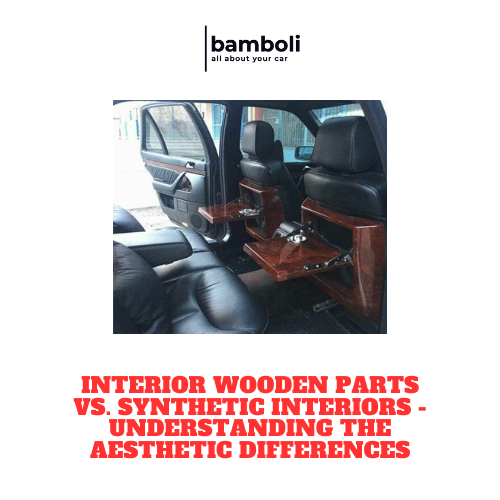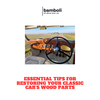Interior Wooden Parts vs. Synthetic Interiors - Understanding the Aesthetic Differences

Interior design, one key decision that homeowners often face is whether to opt for interior wooden parts or synthetic interiors. Both options have their own unique aesthetic appeal and characteristics, which can greatly influence the overall look and feel of a space. By understanding the differences between these two materials, homeowners can make an informed decision that best suits their personal style and preferences.
Main Points:
- Appearance: The aesthetic differences between interior wooden parts and synthetic interiors.
- Durability: How each material holds up over time and in different environments.
- Maintenance: The level of care and upkeep required for interior wooden parts versus synthetic interiors.
- Cost: The price differences between choosing interior wooden parts or synthetic interiors for a space.
- Sustainability: Considerations for the environmental impact of using interior wooden parts versus synthetic interiors.
Natural Beauty of Interior Wooden Parts
Wood has been used in interior design for centuries, and for good reason. Its natural beauty adds warmth, character, and a touch of elegance to any space. From wooden floors to exposed beams, wood brings a unique charm that is hard to replicate with other materials.
Benefits of Using Wooden Parts in Interior Design:
- Durability: Wooden parts are long-lasting and can withstand wear and tear better than many other materials.
- Versatility: Wood can be used in a variety of ways, from flooring to furniture to wall paneling, making it a versatile option for interior design.
- Natural Beauty: The grain patterns, textures, and colors of wood are unique and add a touch of natural beauty to any space.
Whether you prefer a rustic, traditional, or modern look, wooden parts can be incorporated into any design style. They can be stained, painted, or left natural to suit your preferences and enhance the overall aesthetic of your home.
So, if you're looking to add warmth and character to your space, consider incorporating wooden parts into your interior design. Their natural beauty will undoubtedly make a lasting impression on anyone who enters your home.
Durability and Longevity of Synthetic Interiors
Choosing interior materials for your home or office, durability and longevity are essential factors to consider. Synthetic materials have gained popularity in recent years due to their resilience and long-lasting properties.
Benefits of Synthetic Interiors
Synthetic materials such as polyester, nylon, and acrylic are known for their durable nature. They are resistant to wear and tear, making them ideal for high-traffic areas. Additionally, these materials are fade-resistant, meaning they will maintain their color and appearance over time.
Another advantage of synthetic interiors is their water-resistant properties. Unlike natural materials such as wood or leather, synthetic materials are less prone to water damage, making them a practical choice for kitchens and bathrooms.
Longevity of Synthetic Interiors
With proper care and maintenance, synthetic interiors can last for many years. Regular cleaning and occasional spot treatment can help prolong the life of these materials. Additionally, investing in high-quality synthetic materials can ensure even greater longevity.
|
Synthetic Material |
Durability Rating |
Longevity |
|
Polyester |
Excellent |
10+ years |
|
Nylon |
Very Good |
8-10 years |
|
Acrylic |
Good |
5-8 years |
Overall, synthetic interiors offer a cost-effective and durable option for both residential and commercial spaces. By choosing synthetic materials, you can enjoy a beautiful and long-lasting interior for years to come.
Environmental Impact: Wooden Parts vs Synthetic Materials
Choosing materials for furniture, construction, or other projects, it's important to consider the environmental impact of your choices. Two common options are wooden parts and synthetic materials, each with their own set of pros and cons.
Wooden Parts
Wood has long been a popular choice for its natural beauty, durability, and versatility. However, harvesting wood can have a significant impact on forests and ecosystems. Deforestation, habitat destruction, and carbon emissions from logging activities are just a few of the environmental concerns associated with using wooden parts.
Despite these drawbacks, wood is a renewable resource that can be sustainably managed and harvested. By choosing FSC-certified wood or reclaimed timber, you can reduce the negative impact on the environment and support responsible forestry practices.
Synthetic Materials
Synthetic materials, such as plastics, rubber, and composites, offer durability and affordability, but they come with their own set of environmental issues. The production of synthetic materials often involves the use of fossil fuels, which contribute to greenhouse gas emissions and climate change.
Additionally, many synthetic materials are not biodegradable and can take hundreds of years to decompose in landfills, leading to pollution and microplastic contamination in the environment.
It's essential to consider the full life cycle of materials when making choices for your projects. While synthetic materials may offer immediate benefits, the long-term environmental impact should not be overlooked. Choosing wooden parts from sustainable sources or exploring alternative eco-friendly materials can help minimize harm to the planet and promote a more sustainable future.
Aesthetics in Modern Design: Trends and Preferences
In today's fast-paced world, aesthetics play a crucial role in modern design. With constantly evolving trends and preferences, designers are always on the lookout for what is in-demand in the world of aesthetics.
Current Trends in Modern Design Aesthetics
- Minimalism: Clean lines, simple shapes, and neutral colors dominate modern design aesthetics, creating a sense of simplicityand sophistication.
- SustainableMaterials: With a growing emphasis on eco-friendly practices, designers are incorporating sustainable materials like recycled wood and metal into their designs.
- Biophilia: Bringing nature indoors, biophilic design elements such as plants and natural light are becoming increasingly popular in modern interiors.
Consumer Preferences in Aesthetic Design
- Functionality: Consumers today prefer designs that not only look good but also serve a practical purpose, highlighting the importance of utilityin aesthetic appeal.
- Personalization: Customization options are highly sought after, as consumers look for ways to express their individuality and personal style through design choices.
- Technological Integration: Integrating smart technology seamlessly into design is a growing preference, as consumers seek innovativesolutions for convenience and efficiency.
Table: Comparison of Aesthetic Preferences
|
Aesthetic Aspect |
Trend |
Preference |
|
Minimalism |
On the rise |
Strong preference for clean lines |
|
Sustainable Materials |
Increasing popularity |
Consumers prefer eco-friendly options |
|
Biophilia |
Trending |
Growing preference for natural elements |
Maintenance and Care: Wooden Interiors vs Synthetic Options
Choosing interior materials for your home, one of the biggest considerations is the maintenance and care required. Wooden interiors and synthetic options both have their pros and cons in this aspect, so let's take a closer look at the differences.
Wooden Interiors
Durable: Wood is known for its durability and longevity, making it a popular choice for interior design. With proper care and maintenance, wooden interiors can last for decades without losing their charm.
Requires Regular Maintenance: However, wooden interiors do require regular maintenance to keep them looking their best. This includes polishing, sealing, and potentially refinishing the wood to prevent damage from moisture or scratches.
Natural Beauty: One of the biggest draws of wooden interiors is their natural beauty. The grains and textures of wood can add warmth and character to any space, creating a timeless and elegant look.
Synthetic Options
Low Maintenance: Synthetic materials, such as laminate or vinyl, are designed to be low maintenance and easy to clean. They are resistant to moisture, scratches, and other forms of damage, making them ideal for high-traffic areas.
Less Durable: While synthetic options are generally more affordable than wooden interiors, they may not have the same level of durability. They can be prone to fading or peeling over time, especially in areas with heavy wear and tear.
Wide Range of Designs: One major advantage of synthetic options is the wide range of designs and colors available. From imitation wood grain to bold patterns, synthetic materials offer endless possibilities for customizing your space.
In conclusion, the choice between wooden interiors and synthetic options ultimately comes down to personal preference and lifestyle. While wooden interiors require more maintenance, they offer a timeless beauty that can't be replicated. On the other hand, synthetic options are low maintenance and come in a variety of designs to suit any style. Whichever option you choose, remember to prioritize regular care and maintenance to ensure the longevity and beauty of your interior materials.
Frequently Asked Questions
What are the main differences between interior wooden parts and synthetic interiors?
Interior wooden parts offer a more natural and classic look, while synthetic interiors provide a modern and sleek appearance.
Which one is more durable, interior wooden parts or synthetic interiors?
Synthetic interiors are generally more durable and resistant to wear and tear compared to interior wooden parts.
Are interior wooden parts more expensive than synthetic interiors?
Yes, interior wooden parts are usually more expensive due to the cost of materials and craftsmanship involved.
How can I maintain interior wooden parts?
Regular cleaning and polishing with suitable wood care products can help maintain the beauty and longevity of interior wooden parts.
Can synthetic interiors replicate the look of real wood?
Yes, modern synthetic materials are designed to closely resemble the appearance of real wood, offering a cost-effective alternative.




